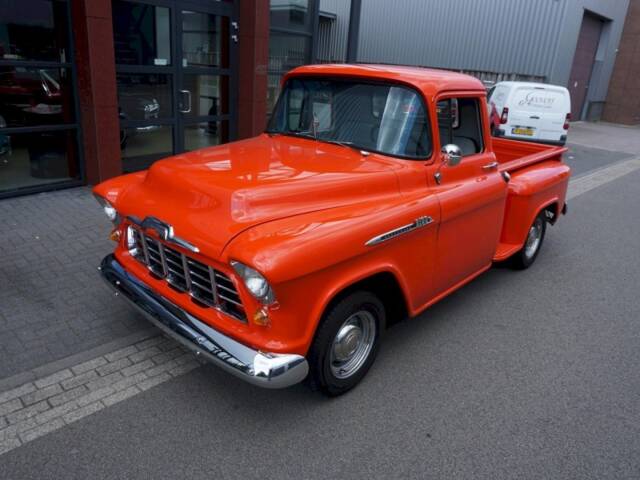Chevrolet Task Force Classic Cars for Sale
The Chevrolet Task Force stands out as a classic American pick-up, produced from 1955 to 1959, known for its robust engineering, innovative features like the wrap-around windscreen, and multiple engine and body configurations. It appeals not just to collectors, but also those after a usable vintage truck with proven capability and style.
Resultados de la búsqueda

History of the Chevrolet Task Force
The Chevrolet Task Force marked a turning point for Chevrolet’s utility vehicles after launching in 1955 as a successor to the Advance Design range. Its development was distinctly focused on bridging the gap between utility and comfort, catering to customer feedback on what a modern light truck should offer. Early innovations included the distinctive wrap-around windscreen, greatly improving visibility for drivers—a novelty at the time. Produced across several U.S. plants, the Task Force line is often referenced as the ‘Second Series’, with its predecessor, the Advance Design, referred to as the ‘First Series’. The Task Force was replaced by the Chevrolet C/K series in 1960, bringing an end to a short but influential production run.
Model History
Succeeding the Advance Design trucks of the early 1950s, the Chevrolet Task Force series introduced a new standard in both design and performance. Available in various configurations—such as half-ton, three-quarter-ton, and full-ton capacities, as well as different bed lengths—the range was flexible to diverse commercial needs. Key developments across its run included the introduction of the deluxe Cameo Carrier and, in 1958, the differentiation into 'Apache' (light duty), 'Viking' (medium duty), and 'Spartan' (heavy duty) models. Each year saw incremental changes: new grille designs, revised badgework, a move toward quad-headlamps in 1958, and options like factory air conditioning for the first time in pickups.
Highlights of the Chevrolet Task Force
The Chevrolet Task Force combined workhorse strength with features rarely seen in pickups of its era. Notable were hydraulic power steering and brakes, a 12-volt electrical system, and the revolutionary curved panoramic glass. With multiple engine options—including inline sixes and small-block V8s—and both manual and automatic transmissions, versatility was a hallmark. The Cameo Carrier’s fibreglass-skinned bed and use of chrome and stainless trim set it apart visually. Multiple body and trim variations—including stepside and fleetside—catered to varied tastes and requirements.
Technical Data
Special Editions and Collectible Models
The rare Cameo Carrier stood out with its fibreglass rear wings and luxury styling touches, targeting buyers wanting car-like comfort in a pickup body. GMC-badged equivalents—branded Blue Chip, including luxury-oriented Suburban models—offered unique badgework and, occasionally, alternative powertrains such as the Pontiac-sourced V8.
Weak Spots and Common Issues
Body corrosion is the chief concern, particularly in the cabin corners and wheel arches. Wiring and electrics can suffer from degradation, given the switch to 12-volt systems during the period. Heaters were not always standard, especially in California-built models, and original wooden beds may deteriorate without proper care. Mechanical parts, though generally robust, may require attention if the truck has seen heavy working use; however, the availability of reproduction and upgrade components in the aftermarket is high.
Engine and Performance, Transmission and Handling
Chevrolet Task Force trucks are recognised for their straightforward, hardworking mechanicals. The availability of V8 power, plus options for four-speed manual and automatic transmissions, allowed significant towing and hauling capability. Steering and braking improvements during the range’s production made these trucks more manageable than their predecessors, and upgrades such as power-assisted brakes and air suspension (in later custom or restored examples) are not uncommon. Ride comfort and handling are typical of 1950s trucks—firm and direct, designed for load-lugging rather than precise feedback, but sufficient for their intended tasks. • 3100 Stepside – Popular for its classic styling and strongest demand (58.9% of views). • 3200 Longbed – Most plentiful in supply (43.8%), popular among users prioritising cargo capacity. • Cameo Carrier – Sought for its unique bodywork and trim. Every variant included the characteristically rounded lines, prominent chrome grille, and practical cabin layout, giving each model its own fanbase within the Task Force community.
Interior, Comfort, Exterior and Design
Signature features include the curved ‘wrap-around’ windshield, prominent chrome detailing, and distinctive two-tone exterior paint options. The stepside body shape remained popular, but fleetside beds and tailored accessories—like period-correct chrome hubcaps, whitewall tyres, and side mirrors—were available for customisation. Interiors ranged from utilitarian rubber-floored layouts to deluxe trims with carpets, headliners, and plush bench upholstery. Optional extras included heaters, radios, and, on some luxury versions, air conditioning. The load bed, finished in oak with stainless strips, signalled a focus on both durability and aesthetics rarely seen in commercial vehicles of the time.
Other Notable Features
Task Force pickups often included bespoke features for specific markets, such as bench or twin-bucket seats, and various combinations of cab trim and exterior badging. Factory-fitted tow hitches and side mirrors were relatively common. The strong network for aftermarket parts and support eases restoration for enthusiasts, and modern upgrades—disc brakes or air-conditioning—are frequently added while keeping the classic aesthetic intact.
Summary
The Chevrolet Task Force lineup embodies American pick-up culture of the late 1950s, blending engineering evolution with enduring design. Its diversity of models—from the practical 3100 stepside to the high-style Cameo Carrier—caters to a broad array of owners, and supply and demand remain robust. With a wide availability of components and extensive community knowledge, restoring and running a Task Force is as accessible as it is rewarding for those drawn to vintage American utility vehicles.
